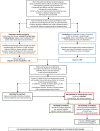Management of Opioid-Induced Constipation and Bowel Dysfunction: Expert Opinion of an Italian Multidisciplinary Panel
- PMID: 34086265
- PMCID: PMC8279968
- DOI: 10.1007/s12325-021-01766-y
Management of Opioid-Induced Constipation and Bowel Dysfunction: Expert Opinion of an Italian Multidisciplinary Panel
Abstract
The prescribing and use of opioid analgesics is increasing in Italy owing to a profusion in the number and types of opioid analgesic products available, and the increasing prevalence of conditions associated with severe pain, the latter being related to population aging. Herein we provide the expert opinion of an Italian multidisciplinary panel on the management of opioid-induced constipation (OIC) and bowel dysfunction. OIC and opioid-induced bowel dysfunction are well-recognised unwanted effects of treatment with opioid analgesics that can profoundly affect quality of life. OIC can be due to additional factors such as reduced mobility, a low-fibre diet, comorbidities, and concomitant medications. Fixed-dose combinations of opioids with mu (μ) opioid receptor antagonists, such as oxycodone/naloxone, have become available, but have limited utility in clinical practice because the individual components cannot be independently titrated, creating a risk of breakthrough pain as the dose is increased. A comprehensive prevention and management strategy for OIC should include interventions that aim to improve fibre and fluid intake, increase mobility or exercise, and restore bowel function without compromising pain control. Recommended first-line pharmacological treatment of OIC is with an osmotic laxative (preferably polyethylene glycol [macrogol]), or a stimulant laxative such as an anthraquinone. A second laxative with a complementary mechanism of action should be added in the event of an inadequate response. Second-line treatment with a peripherally acting μ opioid receptor antagonist (PAMORA), such as methylnaltrexone, naloxegol or naldemedine, should be considered in patients with OIC that has not responded to combination laxative treatment. Prokinetics or intestinal secretagogues, such as lubiprostone, may be appropriate in the third-line setting, but their use in OIC is off-label in Italy, and should therefore be restricted to settings such as specialist centres and clinical trials.
Keywords: Analgesics; Chronic pain; Functional gastrointestinal disorders; Laxatives; Narcotic antagonists; Opioid; Opioid-induced constipation.
© 2021. The Author(s).
Figures


References
-
- Centers for Disease Control and Prevention, National Center for Injury Prevention and Control. U.S. opioid dispensing rate maps. https://www.cdc.gov/drugoverdose/maps/rxrate-maps.html. Accessed 30 Dec 2020.
-
- Legge 15 marzo 2010, n. 38. Disposizioni per garantire l’accesso alle cure palliative e alla terapia del dolore. (10G0056) (GU Serie Generale n. 65 del 19-03-2010). https://www.gazzettaufficiale.it/gunewsletter/dettaglio.jsp?service=1&da.... Accessed 1 Apr 2020.
Publication types
MeSH terms
Substances
LinkOut - more resources
Full Text Sources
Research Materials

